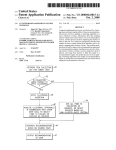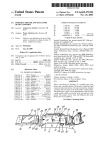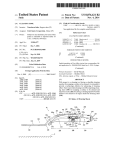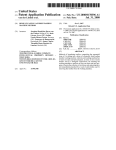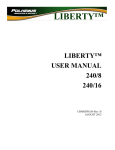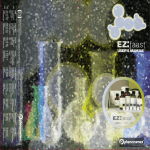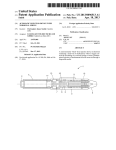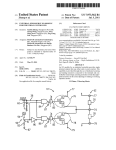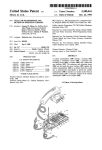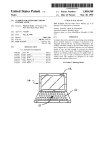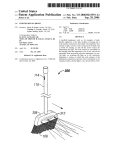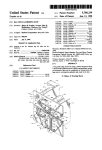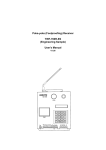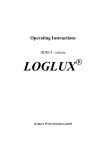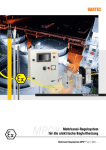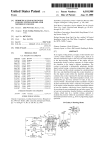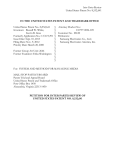Download Support stand apparatus and methods of use
Transcript
US 20120223193Al (19) United States (12) Patent Application Publication (10) Pub. No.: US 2012/0223193 A1 Hurley (54) (43) Pub. Date: SUPPORT STAND APPARATUS AND (52) Sep. 6, 2012 US. Cl. ................................................... .. 248/1631 METHODS OF USE (75) Inventor: Jesse Trevor Hurley, Cottage Grove, WI (US) (57) (73) Assigneez MASTERPIECE OUTDOORS INC Cottage Grove WI (Us) A support stand having a stand base, mounting a tool support. At least ?rst and second stand base legs extendparallel to each (21) Appl_ No; 13/406,598 (22) Filed; Feb 28, 2012 ’ ’ ABSTRACT other beloW intermediate locations of the legs, and converge on each other above the intermediate locations. The parallel portions are readily pushed into soil/ ground using an adult’s Weight. A support leg bracket joins a support leg to the top of the stand base, and accommodates adjusting the support leg Related US, Application Data _ _ _ _ for height, and rotation about a vertical axis. A ?rst tool bracket on the support leg has upright and angular ?anges (60) PrOVlslOnal apphcanon NO' 61/464367’ ?led on Mar' 4’ 2011' Which, collectively, enable rotation of the angular ?ange about a generally horizontal axis. A second tool bracket can _ _ _ _ Pubhcatlon Classl?catlon (51) Int, Cl, F16M 11/20 (200601) be mounted to the support leg. The second tool bracket can rotate about the support leg and has second upright angular ?anges Which, collectively, enable rotation of the second angular ?ange about a second generally horizontal axis. Patent Application Publication Sep. 6, 2012 Sheet 1 0f 6 US 2012/0223193 A1 Patent Application Publication Sep. 6, 2012 Sheet 2 of6 US 2012/0223193 A1 #412 F/QZ MC Patent Application Publication Sep. 6, 2012 Sheet 3 0f 6 J US 2012/0223193 A1 ' .m/rmgp 243 7'1’ P! Q. 2A WM mm? Patent Application Publication Sep. 6, 2012 Sheet 4 0f 6 US 2012/0223193 A1 Patent Application Publication Sep. 6, 2012 Sheet 5 0f 6 Lit? US 2012/0223193 A1 Patent Application Publication Sep. 6, 2012 Sheet 6 0f 6 US 2012/0223193 A1 Sep. 6, 2012 US 2012/0223193 A1 SUPPORT STAND APPARATUS AND METHODS OF USE CROSS REFERENCES TO RELATED APPLICATIONS [0001] This Application is a Non-Provisional of US. Pro pushed into natural soil/ ground using the Weight of a single adult. At the top of the stand base, a support leg bracket joins a support leg to the stand base, Where the support leg bracket accommodates adjusting the support leg both for vertical height and for 360 degrees rotation about the vertical axis of the support leg, Whereby a device attached to the support leg visional Patent Application Ser. No. 61/464,3 67, ?led Mar. 4, can be so adjusted. A ?rst, or only, tool bracket on the support 201 1, the preceding application being herein incorporated by leg has an upright ?ange and an angular ?ange Which, collec tively, enable 360 degree rotation of the angular ?ange, and reference in its entirety. BACKGROUND OF THE INVENTION [0002] This invention relates to portable tool support stands. Speci?cally, this invention relates to supporting cam eras and/or other tools in locations Where the ground surface is uneven, soft, or otherWise not conducive to staple support of a camera or other tool While unattended over an extended period of time, using a conventional tri-pod, and Wherein the tool so supported needs to be pointed in literally any direction about both vertical and/or horiZontal axes. [0003] This invention speci?cally relates to support of motion cameras in Wilderness environments, Where the user leaves the camera unattended, mounted to a support stand, for several days or Weeks at a time. Thus, the stability of the support stand must take into account all Weather and other natural forces typically encountered at the use location. [0004] Thus, it Would be desirable to provide a support thus a device/tool mounted on the angular ?ange, 360 degrees of rotation, about a generally horiZontal axis. A second tool bracket can be mounted to the support leg beloW the ?rst tool bracket. The second tool bracket can rotate 360 degrees about the support leg. The second tool bracket has a second upright ?ange and a second angular ?ange Which, collectively, enable 360 degree rotation of the second angular ?ange, and thus a device/tool mounted on the second angular ?ange, 360 degrees of rotation, about a second generally horiZontal axis. [0013] In a ?rst family of embodiments, the invention com prehends a tool stand, comprising a stand base, the stand base having a top and a bottom, and a height betWeen the top and the bottom, the stand base comprising ?rst, second, and third elongate base legs in ?xed spatial relationship to each other, the ?rst, second, and third base legs having respective ?rst, second, and third loWer ends, respective ?rst, second, and stand Which can be transported to a remote Wilderness use third upper ends, and respective ?rst, second, and third inter mediate loci betWeen the respective upper and loWer ends, the location by a single adult person. [0005] Further, it Would be desirable to provide a support stand Which can be manually installed, ?xedly stable, in a use betWeen the intermediate loci and the loWer ends of the base legs, and converging toWard each other above the intermedi ?rst, second, and third base legs being parallel to each other location, using only the user’s manual capacities. ate loci; and a tool support, having a tool support top and a [0006] tool support bottom, and a tool support height betWeen the tool support top and the tool support bottom, the tool support being adapted to be mounted to the stand base. [0014] In some embodiments, the ?rst and second base legs join the third base leg at ?rst and second ?xed joinder loci at In addition, it Would be desirable to provide one or more driver connectors on the support stand Which are readily employed to apply the user’s Weight to drive base legs of the support stand into the native soil at the use location. [0007] Further, it Would be desirable to provide at least one vertical axis of orientation of a tool support implement and at least one horizontal axis of orientation of such tool imple ment. [0008] Yet further, it Would be desirable to provide such support stand in combination With a second tool support implement Whereby at least ?rst and second tools/cameras can be mounted, independently, to the support stand. [0009] Still further, it Would be desirable to provide such multiple tool/camera mounts Wherein the respective cameras can be separately directed in different directions. [0010] It is yet further desirable to provide such support stand Where a tool support leg can be extended and/or retracted relative to a support base thereby to expand/retract the height of the support stand for use and/or transport. [0011] These and other needs are alleviated, or at least attenuated, or partially or completely satis?ed, by the novel products and methods of the invention. SUMMARY OF THE INVENTION [0012] This invention provides a support stand having a one or more upper portions of the support stand, above a mid-point of the height of the stand base. [0015] In some embodiments, an extension portion of the stand base extends upWardly above the joinder loci and com prises an extension of at least one of the ?rst, second, and third base legs. [0016] In some embodiments, an extension portion of the stand base extends upWardly above the joinder loci, the tool support comprising a tool support leg mounted to the exten sion portion of the stand base by a support leg bracket, the tool support leg having a top and a bottom, and being vertically adjustable by enabled sliding and releasable ?xation of the tool support leg controlled through the support leg bracket. [0017] In some embodiments, the support leg bracket com prises a ?rst laterally extending upper leg mounted to the extension portion of the stand base at a relatively upper loca tion and having a ?rst remote end remote from the extension portion, a second laterally extending loWer leg mounted to the extension portion of the stand base at a relatively loWer loca tion and having a second remote end remote from the exten stand base and a tool support mounted to the stand base. The stand base has at least ?rst and second elongate and narroW sion portion, and an upright bight leg remote from the exten sion portion and connected to both of the ?rst and second base legs Which extend parallel to each other beloW interme diate locations along the lengths of the legs, and converge toWard each other above the intermediate locations, to a join der locus. The parallel portions of the legs are suf?ciently narroW that the loWer portions of the base legs are readily Wherein the support bracket de?nes a generally “U”-shaped bracket having ?rst and second lateral legs and an upright bight leg, a space being de?ned betWeen the ?rst and second lateral legs and on one side by the bight leg. laterally extending legs at the respective remote ends thereof, Sep. 6, 2012 US 2012/0223193 A1 [0018] In some embodiments, ?rst and second apertures extend coaxially through the ?rst and second lateral legs intermediate the extension portion and the respective remote ends of the lateral legs, a third aperture extending through the bight leg intermediate the remote ends of the ?rst and second lateral legs, the tool support leg extending through the ?rst [0030] In some embodiments, the upper portions of at least ?rst and second ones of the base legs, above the intermediate portions, collectively de?ne a sheet material Wrap having a convergingly narroWing cross-section extending toWard the joinder locus. sion portion of the stand base, a set screW threadedly extend [0031] In a second family of embodiments, the invention comprehends a tool stand, comprising a stand base, the stand base having a top and a bottom, and a height betWeen the top and the bottom, the stand base comprising ?rst and second ing through the third aperture and releasably securing an base legs, the ?rst and second base legs having respective ?rst elevation of the extension portion relative to the stand base. [0019] In some embodiments, the ?rst and second lateral and second loWer ends, respective ?rst and second upper ends, and ?rst and second intermediate loci betWeen the respective upper and loWer ends, the ?rst and second base legs, in a use con?guration, being parallel to each other betWeen the intermediate loci and the loWer ends of the base legs and converging toWard each other above the intermediate loci, and being joined to each other at ?xed locations on the and second apertures and across the space betWeen the ?rst and second lateral legs, and thus being spaced from the exten legs have respective ?rst and second thicknesses, and ?rst and second bushings extend through the ?rst and second apertures betWeen side Walls of the ?rst and second apertures and the tool support leg, and across portions of the space betWeen the ?rst and second apertures, each by distances at least as great as the thickness of the respective ?rst or second lateral leg as penetrated by the respective ?rst and second apertures. respective base legs in the respective upper ends thereof, a driver connector connecting the ?rst and second base legs to [0021] In some embodiments, each base leg has a top and a bottom, and each base leg changes direction at least once betWeen the respective top and the respective bottom of a each other and thereby providing at least one driver connector at a height above the bottoms of the respective base legs; and a tool support mounted to the stand base. [0032] In some embodiments, the driver connector is no more than 10 inches above the bottom of the respective base leg, and the loWer ends of the base legs are spaced from each given base leg. other in such use orientation by no more than about 1 5 inches. [0022] [0033] In some embodiments, the ?rst and second base legs join each other above a mid-point of the height of the stand base, at a joinder locus. [0020] In some embodiments, the tool support leg is later ally spaced from the ?rst and second joinder loci, With open space betWeen the tool support leg and the stand base. In some embodiments, each base leg has a top and a bottom, a driver connector extending betWeen, and being rigidly and ?xedly mounted to, at least tWo of the base legs, and thereby providing at least one rigidly and ?xedly mounted driver connector at a height of no more than 10 [0034] In some embodiments, one of the ?rst and second inches above the bottoms of the respective base legs. base legs is straight betWeen the respective upper and loWer ends of the respective base leg, and Wherein the stand base is [0023] limited to no more than tWo base legs. In some embodiments, a ?rst driver connector extends betWeen, and is mounted to, the ?rst and second base legs, a second driver connector extending betWeen, and being mounted to, the second and third base legs, and a third driver connector extending betWeen, and being mounted to, the third and ?rst base legs. [0024] In some embodiments, the stand base has a top and a bottom, and a mid-point halfWay betWeen the top and the bottom, and a driver connector mounted to, and extending laterally from, opposing sides of the stand base above the midpoint. [0025] In some embodiments, the tool stand further com prises a tool bracket mounted to the tool support leg at the top of the tool support leg. [0026] In some embodiments, the tool bracket comprises a transversely extending ?ange, and an angular ?ange releas ably and rotatably mounted to the transversely extending ?ange. [0027] In some embodiments, the tool stand further com [0035] In some embodiments, an extension portion of the stand base extends upWardly above the joinder locus, the tool support comprising a tool support leg mounted to the exten sion portion of the stand base by a tool support bracket, the tool support leg being vertically adjustable by enabled sliding and releasable ?xation of the tool support leg, controlled through the support leg bracket. [0036] In a third family of embodiments the invention com prehends a tool stand, comprising a stand base, the stand base having a top and a bottom, and a height betWeen the top and the bottom, the stand base comprising ?rst and second base legs, the ?rst and second base legs having respective ?rst and second loWer ends, respective ?rst and second upper ends, and ?rst and second intermediate loci betWeen the respective upper and loWer ends, the ?rst and second base legs being parallel to each other betWeen the intermediate loci and the loWer ends of the base legs and converging toWard each other at converging portions thereof above the intermediate loci, prises a second tool bracket releasably and rotatably mounted and a driver connector extending betWeen the ?rst and second to the tool support, adjustable vertically along the heights of legs, and connecting the ?rst and second base legs to each other, at locations on the converging portions of the base legs the tool support betWeen the tool bracket and the stand base. [0028] In some embodiments, the second tool support bracket is mounted for 360 degrees rotation about a vertical axis by either or both of (i) rotation of the second tool support bracket about the tool support, and (ii) rotation of the tool support about the stand base. [0029] In some embodiments, the second tool support having third and fourth ends, respectively aligned With the bracket comprises mounting structure mounting the tool sup port bracket to the tool support, a mounting plate extending transversely from the mounting structures, and a device plate releasably and rotatably mounted to the mounting plate. ?rst and second ends of the upper lateral leg; a bight leg rigidly connected to both of the second and fourth ends of the ?rst and second lateral legs such that the upper lateral leg overlies the loWer lateral leg When the bight leg is in a vertical above the intermediate loci; and a tool support mounted to the stand base. [0037] In a fourth family of embodiments, the invention comprehends a mounting bracket, comprising an upper lat eral leg having ?rst and second ends; a loWer lateral leg Sep. 6, 2012 US 2012/0223193 A1 orientation, thereby de?ning a bracket space betWeen the [0044] upper and lower lateral legs, and bounded on one side by the rotated 360 degrees With respect to the stand base, thereby to In some embodiments, the tool support can be bight leg; ?rst and second apertures extending coaxially rotate the second camera 3 60 degrees With respect to the stand through the upper and loWer lateral legs intermediate the respective ends of the upper and loWer lateral legs; a third base. In some embodiments, the generally U-shaped bracket can be rotated 360 degrees With respect to the tool support. [0045] In a sixth family of embodiments, the invention comprehends a method of emplacing a camera, comprising threaded aperture extending through the bight leg intermedi ate opposing ends of the bight leg; a set screW extending through the third aperture and into the bracket space; a mount ing plate extending transversely from the bight leg and aWay from the upper and loWer lateral legs such that the mounting plate is generally equidistant from both of the upper and loWer lateral legs; and a device plate releasably mounted to the mounting plate so as to be rotatable With respect to the mount ing plate, a portion of the device plate extending transverse to the mounting plate. emplacing a camera support stand at a selected location, such camera support stand assembly comprising a stand base, the stand base comprising ?rst and second base legs in ?xed spatial relationship to each other, the ?rst and second base legs having respective ?rst and second loWer ends, respective ?rst and second upper ends, and ?rst and second intermediate loci betWeen the respective upper and loWer ends, the ?rst and second legs being parallel to each other at the loWer ends of the base legs, beloW the intermediate loci and converging [0038] In some embodiments, the device plate extends in a direction generally in common With direction of extension of toWard each other above the intermediate loci, a driver con the lateral legs aWay from the bight leg. nector rigidly and ?xedly connecting the ?rst and second base [0039] In some embodiments, the invention comprehends a tool stand, comprising a stand base; a tool support, the tool support being mounted to the stand base; and a such mounting tive base legs, the method comprising positioning the camera bracket releasably mounted to the tool support so as to accom modate 360 degree rotation of the mounting bracket With respect to the standbase. In some embodiments, the mounting bracket is mounted to the tool support so as to accommodate 360 degree rotation of the mounting bracket With respect to the tool support. [0040] In some embodiments, the tool stand further com prises a camera releasably mounted to the device plate. [0041] In a ?fth family of embodiments, the invention com prehends a mounted assembly, comprising a generally U-shaped bracket comprising upper and loWer lateral legs each having respective opposing ends, a bight leg rigidly connecting the upper and loWer lateral legs to each other With the upper lateral leg overlying the loWer lateral leg, ?rst and second apertures extending coaxially through the upper and loWer lateral legs intermediate the respective opposing ends thereof; a mounting plate al?xed to, and extending trans versely from, the bi ght leg and aWay from the upper and loWer lateral legs such that the mounting plate is generally equidis tant from both of the upper and loWer lateral legs; a device plate releasably mounted to the mounting plate so as to be rotatable With respect to the mounting plate, a mounting panel of the device plate extending transverse to the mounting plate; and a camera mounted to the mounting panel and thereby being supported by the mounting bracket. [0042] In some embodiments, the invention comprehends a tool stand, comprising a stand base; and a tool support, mounted to the stand base, a mounted assembly comprising a generally U-shaped such bracket, a such mounting plate, a such device plate, and a such camera being mounted to, and supported by, the tool stand. [0043] In some embodiments, the supported assembly comprises a such tool stand, including the stand base, the tool support, and the mounted assembly, and further comprises a legs to each other at a height above the bottoms of the respec support stand assembly at the selected location on a natural soil surface With the loWer ends of the legs pointing doWn Wardly; manually pushing on the driver connector With a single adult person’s Weight and thereby driving the base legs into natural soil far enough that the camera support stand can reliably support itself in a routine natural-Weather environ ment for an extended period of time While unattended; and mounting a camera on the camera support stand assembly. [0046] In some embodiments, the selected location com prises a ?rst selected location, the method further comprises manually pulling the support stand out of the natural soil, moving the support stand to a second selected location dis placed from the ?rst selected location, again on a natural soil surface, and again manually pushing on the driver connector With a single adult person’s Weight and thereby again manu ally driving the base legs into natural soil such that the camera support stand can again reliably support itself in a typically natural -Weather environment. [0047] In some embodiments, the method includes moni toring activities at multiple locations using a single camera, the method comprising emplacing such camera at a ?rst such selected location, and collecting a ?rst set of images While the camera is located at the ?rst selected location, manually pull ing the camera support stand out of the natural soil at the ?rst selected location, moving the camera support stand to a sec ond selected location over natural soil and emplacing such camera at the second selected location by again manually pushing on the driver connector With a single adult person’s Weight and thereby again manually driving the base legs into natural soil and thereby emplacing the camera at the second selected location, and collecting a second set of images While the camera is located at the second selected location. BRIEF DESCRIPTION OF THE DRAWINGS the second mounting plate, a mounting panel of the device plate extending transverse to the second mounting plate, a second camera being mounted to the second mounting panel [0048] FIG. 1 is a full-height pictorial vieW of a support stand of the invention. [0049] FIG. 2 is a pictorial vieW of the stand base of the support stand of FIG. 1, With a second embodiment being shoWn in dashed outline. [0050] FIG. 2A is a pictorial vieW as in FIG. 2 Wherein upper portions of the base legs have been replaced With an and thereby supported by the second mounting bracket. upWardly converging sheet material Wrap. second bracket mounted to the tool support, the second bracket comprising a second mounting plate mounted to the tool support, and a second device plate releasably mounted to the second mounting plate so as to be rotatable With respect to Sep. 6, 2012 US 2012/0223193 A1 [0051] FIG. 3 is a pictorial vieW ofthe tool support portion of the support stand of FIG. 1, including the support leg bracket, the upper mounting bracket, and the second/interme diate mounting bracket. [0052] FIG. 4 is an enlarged vieW of the upperportion of the tool support, including the upper mounting bracket detail. [0053] FIG. 5 is an enlarged pictorial vieW of the interme diate mounting bracket mounted on the tool support. [0054] The invention is not limited in its application to the details of construction, or to the arrangement of the compo nents set forth in the folloWing description or illustrated in the draWings. The invention is capable of other embodiments or of being practiced or carried out in various other Ways. Also, it is to be understood that the terminology and phraseology employed herein is for purpose of description and illustration and should not be regarded as limiting. Like reference numer als are used to indicate like components. DETAILED DESCRIPTION OF THE ILLUSTRATED EMBODIMENTS [0055] FIG. 1 generally illustrates the support stands of the invention. In general, a tool support stand 10 includes a stand base 12 and a tool support 14 mounted to the stand base. As illustrated in FIG. 1, stand base 12 has a top and a bottom, and [0059] The change in directions of base legs 16B, 16C, in the case of steel rod, expresses the results of the steel rods having been subjected to a bending process, optionally tWo pieces of steel rod being joined at the desired angle by a Welding process. Such change in direction at the intermediate loci can also be accomplished With a joint Wherein the loWer portion of the leg can articulate With respect to the upper portion of the leg, articulating betWeen a limited number of pre-selected angles betWeen the upper and loWer portions of the legs. [0060] In the embodiment illustrated in FIG. 1, beloW the elevation of intermediate portions 1 6BI, 16CI, and yet remote from the bottoms of the base legs, driver connectors 22 extend generally horizontally across the spaces de?ned betWeen the respective loWer, and parallel, portions of the base legs, including betWeen respective portions of base leg 16A, and base legs 16B and 16C, at heights above the bottom of the stand corresponding to the heights of such joinder at base legs 16B and 16C. Thus, a ?rst driver connector extends horiZon tally betWeen base leg 16A and base leg 16B; a second driver connector extends horizontally betWeen base leg 16B and base leg 16C; and a third driver connector extends horiZon tally betWeen base leg 16C and base leg 16A. In FIG. 1, the second driver connector betWeen base leg 16B and base leg 16C is shoWn fragmented in order to clarify that the second includes ?rst, second, and third elongate base legs 16A, 16B, driver connector is not connected to, and indeed passes and 16C. At the top of the stand base is a support leg bracket behind, base leg 16A, Whereby base leg 16A is closer to the 18. vieWer than are base legs 16B or 16C in FIG. 1. [0056] In the embodiment illustrated in FIG. 1, each base leg has a bottom at the bottom of the support stand and correspondingly at the bottom of the stand base, and a top at, or in the vicinity of, the top of the stand base. Base leg 16A, as illustrated in FIG. 1, is straight and extends from the bottom of the stand base to the top of the stand base such that, in a stand-upright orientation, in general, base leg 16A extends vertically from the bottom of the leg to the top of the leg. Base legs 16B and 16C have loWer portions 16BL, 16CL, [0061] While three driver connectors are shoWn connecting the loWerportions of the legs, a single driver connector, or tWo driver connectors, can be used. [0062] In embodiments Where the base legs are articulated at the joinder loci and at the intermediate loci, the driver connectors may also be articulated at their joinders With the base legs. In such case, a given driver connector can have an articulation joint betWeen its joinders With respective ones of the base legs, thereby to fold as the base legs articulate about upperportions 16BU, 16CU, and intermediate portions 16AI, the joinder loci. 16BI, 16CI. BeloW intermediate portions 16BI, 16CI, the loWer leg portions 16BL, 16CL are parallel to each other and parallel to base leg 16A. Base legs 16B and 16C change [0063] The function of driver connectors 22 is tWo-fold. First, driver connectors 22 are rigid, sturdy structures once unfolded, or alWays if such driver connectors are so designed that the driver connectors do not fold. For example, in the directions at intermediate leg portions 16BI 16CI such that the upper portions 16BU, 16CU of base legs 16B, 16C con verge toWard a common joinder locus 20 on base leg 16A at rigid, non-folding con?guration, the driver connectors can be made With the same type of 3/8 inch steel rod used for the base legs, Where the driver connectors are rigidly attached to the the upper ends of base legs 16B, 16C and toWard the top of base leg 16A. Base leg 16A includes an extension portion 16AEP, Which extends upWardly from joinder locus 20 to the top of the stand base at the top of support leg bracket 18. [0057] Base legs 16A, 16B, 16C can be made ofany mate base legs are steel, or melt bonding or suitable adhesive Where the driver connectors and base legs are polymeric. Other methods of attachment can be used. In any event, the driver rial Which is suf?ciently strong, stiff, and rigid to provide the connectors, by their sturdy structures, and rigid connections base legs, such as by Welding Where the driver connectors and desired level of support. Examples of such materials can be in the extended con?guration, serve to reinforce and preserve selected from metals such as steel or aluminum, or from the spatial relationships betWeen the respective pairs of legs at plastics such as polyethylene, polypropylene, or polyvi the loWer portion of the stand base, much like truss Webs reinforce and maintain the spatial relationships betWeen the stringers in a truss. HoWever, in the folding con?guration, such spatial relationships can be collapsed as the driver con nectors fold in combination With the base legs being articu nylidene chloride, as Well as from other metals or polymers, including pultruded e.g. ?berglass-reinforcedpolymers. Base legs 16B and 16C can be rigidlyjoined to base leg 16A at the joinder locus by eg Welding, plastic melt-bonding, clamp ing, pinning, or other knoWn mechanical fastening or melt joinders. In the alternative, base legs 16B and 16C can be joined to base leg 16A by one or more pivoting joints, albeit at a ?xed location on base leg 16A. [0058] In the embodiments illustrated herein, the base legs are fabricated using 3/8 inch thick steel rod, and base legs 16B, 16C are Welded to base leg 16A atjoinder locus 20. lated toWard each other for a more compact structure for eg transportation. [0064] Second, driver connectors 22, When fully extended, provide a convenient structure/tool for driving the legs of the support stand/stand base into natural soil. Namely, the spac ing betWeen the respective base legs is great enough that the lengths of the driver connectors are long enough, for an adult Sep. 6, 2012 US 2012/0223193 A1 to place eg the full Width of their shoe/boot on a respective base legs, including base leg 16A, extend at acute angles to driver connector, so as to effectively apply their body Weight the vertical. In such implementation, one of the base legs, to the shoe/boot on the driver connector With su?icient force such as base leg 16A, embodies a secondbend at or proximate to drive the loWer portions of the base legs into natural soil, optimally to the elevation of the driver connector, such that the full lengths of the legs, up to the driver connectors, are under the surface of the soil. HoWever, the distance betWeen the legs at driver connectors 22, in the fully extended con ?guration, is typically limited to that needed to apply a user’s foot/boot. Thus, the distance betWeen at least tWo of the legs, joinder locus 20 in order to provide the desired vertical pre sentation of the base leg extension portion of the stand base to support leg bracket 18. In the alternative, if the base leg extension portion is not vertical, bracket 18 and/ or extension portion 16AEP can be modi?ed accordingly in order to pro vide for a generally vertical orientation of tool support 14. [0069] In other embodiments, only tWo base legs 16 are used to support the stand base. In such embodiments, both at the driver connector, is typically no more than about 20 inches, more typically no more than about 15 inches, still more typically no more than about 12 inches. legs, including the extension portion, typically, though not [0065] The lengths of the base legs beloW the driver con nector are long enough that, When the base legs are driven into the soil/ground up to the heights of the driver connectors, the necessarily, generally reside in a common plane. Both base legs can be bent/ change directions, and at least one leg has a second bend above the joinder locus to provide the base leg extension portion 16AEP. Or both legs can change direction lengths of the base legs in the ground/ soil are long enough to at the intermediate portions e.g. intermediate portions 16AI, hold stable that portion of the tool stand Which is above the illustrated in FIG. 1, the stand is not subject to being bloWn 16BI and terminate at the joinder locus, and a third element extends up from the joinder locus, as the extensionportion. Or one of the base legs can be straight, including extending straight upWardly from the joinder locus, as the extension portion. Or one base leg can be straight and the other base leg over by common Winds or other inclement Weather. In typical has a ?rst bend at its oWn intermediate locus and a second embodiments, the driver connectors are no more than 10 bend at or proximate the joinder locus Whereby that other base soil surface, under typical Weather conditions. Thus, the tool stand, When suitably installed, With the base legs driven into the soil up to e. g. the heights of the driver connectors as inches above the bottoms of the legs, optionally 6-10 inches above the bottoms of the legs, optionally 8-10 inches above the bottoms of the legs. Such distances have been found to be generally reliable for stabiliZing such tool stand having a maximum extended height of eg 45-55 inches above the ground When about 6 inches of the base legs is beloW the leg extends generally vertically upWardly as the extension portion. [0070] In the alternative, all the legs can come together at the joinder locus, With one of the legs straight at the interme diate locus, or all the legs changing directions at the interme diate locus, and an additional structural support element is ground surface, and Without suggesting driving the base legs secured to the legs at the joinder locus, to serve as the base leg to such depth that the resistance of the soil/ground becomes a substantial obstacle to driving the base legs to the heights of the driver connectors or pulling the base legs out of the extension portion, in support of support leg bracket 18. ground. [0066] In the alternative, the driver connector structure can be above the intermediate portions of the respective base legs, including above the mid-points of the legs, and extending across the upper portions of the base legs, as shoWn in dashed outline in FIG. 1. In the case Where the driver connector extends across the upper portions of the legs, the distance betWeen the base legs is smaller, such that a driver connector con?ned to the distance betWeen the base legs may not be long enough to be easily accessed for the driving function. In such case, and as illustrated in dashed outline, the driver connector extends beyond the legs in order to be more readily accessed by the user’s hands for the action of driving the base legs into the ground using the user’s body Weight as applied through the user’s hands. Also in such case, the user uses their oWn j udgment regarding hoW far the loWer portions of the legs should be driven into the soil/ ground to stabiliZe the tool stand in its installed condition. Typically, the base legs Will be designed such that the tool stand is stable by the time the legs are driven into the ground/soil to the heights of the bends at the intermediate portions of the base legs. [0067] Further as illustrated in dashed outline in FIG. 1, a single driver connector can be used Where the spatial ?xation of all three legs by the driver connector is not needed. [0068] FIG. 2 clearly shoWs base leg 16A as straight, While base legs 16B, 16C are bent at the intermediate portions. FIG. 2 further shoWs base leg 16A displace in dashed outline and labeled 16, bent, such that all three legs can be bent if desired. In such case, When the support stand is in an upright, gener ally vertical, orientation the converging portions of all three [0071] Further, more than three legs can be used. Thus, in the claims Which folloW, Where ?rst and second base legs, or ?rst, second, and third base legs are recited, such recitations contemplate as Well e.g. third, fourth, ?fth etc. legs as optional. HoWever, the number of legs beloW the driver con nector(s) Will typically not be greater than 6 legs. [0072] In some embodiments, the base legs betWeen eg the intermediate portions and the joinder locus can be embod ied in a sheet material having an upWardly-converging-nar roWing cross-section Which is suf?ciently structurally sturdy to support the support leg bracket 18, including all of tool support 14 and any tools mounted thereon. [0073] Thus, it is clear that the base legs can take on a number of variations, in terms of number of legs, Whether all the base legs change directions or Whether one of the base legs is straight, Whether one or more base legs changes direction more than once, base leg material, methods ofjoining the base legs to each other at the joinder locus, and reinforcement of the base leg structure using driver connectors 22. Further, at and/or above the bend/ direction changes in the legs, the indi vidual legs can be replaced by a sheet material Which extends from, generally, the tops of the loWer portions of the legs, toWard the joinder locus, and can also replace the base leg extension portion up to support leg bracket 18. FIG. 2A shoWs such sheet material as 168, replacing the base legs up to the joinder locus 20. [0074] As illustrated collectively in FIGS. 1-3, support leg bracket 18 supports tool support 14 generally, and speci?cally supports tool support leg 24 from stand base 12. [0075] Returning to FIGS. 2 and 3, support leg bracket 18 has an upper lateral leg 24, a loWer lateral leg 26, and a bight leg 28. Upper lateral leg 24 has a ?rst remote end, remote from Sep. 6, 2012 US 2012/0223193 A1 bight leg 28, a ?rst proximal end adjoining bight leg 28, and a ?rst thickness “T1”. Lower lateral leg 26 has a second remote end, remote from bight leg 28, a second proximal end adjoining bight leg 28, and a second thickness “T2”, Which is typically, but not necessarily, equivalent to the thickness “T1” of lateral leg 24. Collectively as shoWn, upper lateral leg 24, bight leg 28, and loWer lateral leg 26 de?ne a continuous U-shaped strip of material, Where the proximal ends of the lateral legs merge into the upper and loWer ends of the bight leg. [0076] While support leg bracket 18 can be joined to exten sion portion 16AEP of base leg 16A by any of a variety of mechanical joinder methods, in the illustrated embodiments, the lateral and bight legs of bracket 18 are steel, as is base leg 16A, and bracket 18 is joined to extension portion 16AEP by Welds at the remote ends of lateral legs 24, 26. As With the base legs, the lateral and bight legs of bracket 18 can as Well be made of other materials so long as those materials provide illustrated embodiments, is about 30 mm, and the distance across space 32 betWeen bight leg 28 and base leg extension portion 16AEP is about 30 mm. [0083] Tool support 14 includes a tool support leg 38 and a tool bracket 40. In the illustrated embodiments, tool support leg 38 is a steel rod having a constant diameter of about 3/8 inch along the entirety of its length. Tool support leg 38 extends through apertures 34 and bushings 36, and thus through lateral legs 24, 26 of support leg bracket 18 and across space 32, approximately midWay betWeen base leg extension portion 16AEP and bight leg 28. [0084] Set screW 42 extends through, and engages the threads of, aperture 35 in bight leg 28 and is driven against the side of tool support leg 38. The driving of set screW 42 laterally against the side of tool support leg 38 imposes a lateral stress on tool support leg 38 su?icient to create a frictional engagement betWeen the end of set screW 42 and the the strength, stiffness, rigidity, and the like required to support side of tool support leg 38. Choosing to not be held to theory, a tool Which is desired to be supported by the tool stand. In light of the above description, support leg bracket applicant believes that the side stress caused by set screW 42 on tool support leg 38 also causes enough bend response in 18 is rigidly mounted to the top/extension portion of the stand base, With enough structural support betWeen the stand base tool support leg 38 in space 32 that tool support leg 38 applies [0077] and the bracket that the bracket can provide the desired level of structural support to tool support 14. [0078] The combination of lateral legs 24, 26 and bight leg 28 collectively de?ne a space 32 betWeen the respective three legs and the unbounded side of such space, Which unbounded lateral stresses on the inner surfaces of bushings 36, suf?cient to incrementally increase the net friction betWeen bushings 36 and tool support leg 38; With the consequence that such increased net friction betWeen bushings 36 and tool support leg 38 provides a signi?cant contribution to the holding poWer of set screW 42, holding tool support leg 38 at a “set” vertical side is de?ned by an imaginary line (not shoWn) betWeen the remote ends of lateral legs 24, 26. elevation once the set screW is driven against the side of tool [0079] Apertures 34 extend, top-to-bottom, through each of [0085] With set screW 42 retracted, tool support leg 38 can be moved vertically up and doWn Within tool support bracket 18 through apertures 34 and bushings 36. Once a desired elevation is achieved for the tool support leg, set screW 42 is the upper and loWer lateral legs, intermediate the remote and proximal ends of the respective lateral legs. Aperture 34 in the upper lateral leg is coaxial With aperture 34 in the loWer lateral leg, such that the apertures 34 in the lateral legs are aligned With each other across space 32. A threaded aperture 35 support leg 38. driven/tightened against the side of tool support leg 38 in space 32, thus temporarily setting/?xing the height of the tool extends laterally through bight leg 28 and a central axis of support leg on support stand 10. When the user desires to aperture 35 intersects the central axes of apertures 34 in the change the height of the tool support, thus the height of tool lateral legs. [0080] Shoulder bushings 36 extend through apertures 34 in lateral legs 24, 26. A shoulder bushing 36 has an enlarged support leg 38, set screW 42 is WithdraWn from contact With the tool support leg, thus freeing the leg to be again vertically adjusted. Such adjustment of the tool support leg alloWs the shoulder on one end thereof Which prevents the bushing from overall height of support stand 10 to be reduced/collapsed for being pushed entirely through the aperture. Thus, the bushing transportation such as commercial shipping eg to a cus tomer, transport in a vehicle to a use property, and/or for is inserted into the aperture and pushed along the length of the bushing until the shoulder impacts the leading edge of the respective lateral leg at the aperture. The shoulder structure assures that the bushing is properly longitudinally positioned in the aperture. [0081] Bushings 36 are elongate bushings Which extend entirely through the respective apertures, and extend across space 32 beyond the end of the aperture remote from the inserting aperture end by a distance approximately at least as great as the thickness “T1”, “T2” of the respective lateral leg, leaving an non-bushed portion of the distance across space 32 betWeen the upper and loWer bushings 36. As usual With bushings, the outer diameters of the bushings closely approxi mate the diameters of the apertures 34 into Which the bush ings are assembled. [0082] In an exemplary embodiment of the support leg bracket, thicknesses “T1” and “T2” of lateral legs 24, 26 are about 4 mm, and the corresponding thickness of bight leg 28 is about 4 mm. The side Walls of bushings 36 are about 1 mm thick. Bushings 36 each extend about 6 mm into space 32. The distance across space 32 betWeen lateral legs 24 and 26, in the manual transport of the stand from the vehicle to an emplace ment site. Similarly, once the stand is at an emplacement site, the height of the stand is readily increased by extending the tool support leg through tool support bracket 18 and again applying the set screW against the tool support leg in space 32. [0086] Turning noW to FIGS. 3 and 4, tool bracket 40 includes a transversely extending rigid upright ?ange 44 and a rigid angular ?ange 46. Upright ?ange 44 is generally embodied in an uprightly oriented ?at plate, eg a metal or hard plastic plate, extending parallel to, and transversely from tool support leg 38, such that an elongate proximal edge 47 of the ?ange 44 extends along the length of support leg 38, and is rigidly attached to support leg 38. Such rigid attachment may be permanent or temporary. A permanent attachment may be achieved by eg Welding the plate to the support leg. A temporary attachment may be achieved by using a suitably designed bracket or the like. In the illustrated embodiments, ?ange 44 is permanently attached to support leg 38 by a Weld 49 Which extends the full length of the edge of ?ange 44 Where the ?ange meets the support leg. Sep. 6, 2012 US 2012/0223193 A1 [0087] Angular ?ange 46 has a ?rst rigid plate 48 disposed in surface-to-surface relationship With a major surface of upright ?ange 44. A second rigid plate 50 is disposed at generally a right angle to plate 48 and extends aWay from upright ?ange 44. [0088] A ?rst hole (not shoWn) extends through upright ?ange 44 at a location substantially displaced from support leg 38. A second hole 52 extends through upright plate 48 as illustrated in FIG. 3. Second hole 52 is threaded. A thumb screW 54 extends through the ?rst hole in upright ?ange 44 and engages the threads in hole 52 in upright plate 48, releas ably mounting angular ?ange 46 to upright ?ange 44. [0089] With support stand 10 in an upright orientation, and While thumb screW 54 is engaged in hole 52 but not tightened, angular ?ange 46 can be rotated about thumb screW 54, thus to select a desired angle of orientation of ?ange 46 relative to [0094] Once the base legs of support stand 10 have been driven into the ground/ soil, thereby stabiliZing the stand at the selected location, the elevation of the tool/camera 58 can be changed, and the tool/camera can be oriented in any direction relative to base legs 16 by loosening set screW 42. With set screW 42 loosened, tool support leg 38 can be repositioned for elevation and angular rotation, thus raising or loWering the camera and rotating the camera to any desired angle about the vertical axis de?ned by the tool support leg. Once the desired elevation and angle have been achieved, set screW 42 is tight ened, thereby temporarily ?xing the elevation and angle of the camera relative to support leg 38. [0095] In light ofthe above, a camera 58B can be pointed in any desired up/doWn direction by manipulation of the camera 58 and screW 54. The camera can be raised or loWered, and ?ange 44 and thus relative to the ground. With second plate 50 oriented in any direction about a vertical axis by manipulation of tool support leg 38 or any element attached to the support leg, in combination With manipulation of set screW 42 on at the desired angle of orientation, thumb screW 54 can be support leg bracket 18. tightened to temporarily lock ?ange 46, and thus the second plate 50, at the desired angle of orientation relative to upright ?ange 44, thus at the desired angle of orientation relative to the ground. If/When a second different angle is desired, thumb screW 54 is loosened, angular ?ange 46 is moved to the second different angle, and thumb screW 54 is again tight ened. [0090] A third hole 56 extends through second plate 50 at a convenient location on plate 50. With thumb screW 54 loosely [0096] Tool support stand 10 can be used as above described to support a single camera, and Wherein that single camera can be positioned and oriented to point in literally any direction, at any up or doWn angle, and at any angle in a 360 degree radius about the standbase, at any time, including after the stand has been ?xedly driven into the underlying soil/ ground. Such 360 degree radius potential is indicated by double headed arroW 64 circling support leg 38 in FIG. 3. Thus the orientation of the stand base imposes no limits on the mounting angular ?ange 46 to ?ange 44, ?anges 44 and 46 are user’s ability to select any direction in Which to point the so positioned relative to each other and relative to support leg 38 that ?ange 46, When rotating about thumb screW 54, can camera or other tool mounted to the support stand. extend freely across, and in front of, support leg 38 Without being blocked by support leg 38.Accordingly, a camera 58, or other tool, can be mounted to tool bracket 40 by driving an e.g. thumb screW 60 through the third hole 56 in the second plate 50 and into the respective tool, and the camera can be freely rotated about screW 54 to a desired angular orientation, about the generally horizontal axis of screW 54 unless/until the camera or other tool, itself comes up against support leg 38. In such instance, the desired angle can still be achieved by a combination of rotating support leg 38 and ?ange 46. [0091] A such camera 58 is shoWn in side vieW in FIG. 1, mounted to that surface of plate 50 Which is most remote from plate 48. A ?rst camera 58A is a bottom-mount camera Wherein screW 60 extends through plate 50 and into a threaded hole in the bottom of the camera body. FIG. 1 also illustrates the end of thumb screW 54 as seen through hole 56. [0092] FIG. 4 shoWs a second camera 58B mounted to the same surface of the same plate 50 at a different time. HoW [0097] HoWever, in some instances, and for some uses, it is desirable to mount a second and/or third and/or fourth, etc. camera or other tool to the same support stand, all at the same time. For example, a user may Wish to simultaneously moni tor activity in more than one direction, Whereby it Would be desirable to mount a second and/ or third camera to the support stand. [0098] In FIGS. 3 and 5, a second tool bracket 66 has upper and loWer lateral legs 68, 70, bight leg 72, apertures 74 through the lateral legs, threaded aperture 76 through bight leg 72, bushings 78 in apertures 74, and set screW 80 through aperture 76 extending across space 82 and impacting support leg 38, all generally corresponding to corresponding struc tures and functions in support leg bracket 18. HoWever, the remote ends 81 of lateral legs 68, 70 are not independently mounted to anything. Rather, the stress imposed on support leg 38 by set screW 80, in combination With the apparent friction applied at bushings 78 holds second tool bracket 66 at a desired elevation on support leg 38. The elevation of bracket ever, the second camera 58B is a rear-mount camera Wherein 66 is readily adjusted by loosening set screW 80 and moving screW 60 extends through plate 50 and into a threaded hole in the bracket to the desired elevation. At the same time, namely the back or the camera body. While the set screW is in its loosened condition, bracket 66 can [0093] As suggested in FIGS. 1 and 4, the upWard or doWn Ward direction in Which the lens 62 of the camera points can be rotated about support leg 38 as illustrated by double headed arroW 84 in FIG. 3, in order to set bracket 66 at any be controlled by adjusting such angle When screW 54 is rela desired 360 degree orientation about the axis of support leg tively loose. Thus, the user can adjust the up or doWn direction 38. Thus, set screW 80 enables setting bracket elevation as in Which the camera points by loosening screW 54, rotating Well as bracket rotational angle relative to support leg 38. ?ange 46 relative to ?ange 44 and screW 54 to a desired [0099] up/doWn angle, and While holding that angle, tightening Which is ?xedly attached to support leg 38 and extends trans versely aWay from the support leg, in bracket 66 a similar screW 54. The tightening of screW 54 draWs ?ange 46 into Referring to tool bracket 40 and upright ?ange 44 orientation relative to ?ange 44 until screW 54 is loosened upright ?ange 86 is ?xedly attached to bight leg 72 and extends transversely aWay from the bight leg. [0100] Again referring to tool bracket 40 and angular ?ange suf?ciently to release such frictional engagement. 46 Which is mounted to upright ?ange 44 through a hole (not frictional engagement With ?ange 44 such that ?ange 46, and thus the camera, is temporarily held in the ?xed angular Sep. 6, 2012 US 2012/0223193 A1 shown) by screw 54, and wherein angular ?ange 46 can rotate force of the user’s weight, in most cases, drives legs 16 into about ?ange 44 and screw 54 thus to set any up/down direc tion in which a camera can be pointed; in bracket 66, angular the ground. Except where the ground/ soil is extremely hard, ?ange 88 is mounted to upright ?ange 86 through a hole (not shown) in ?ange 86 by screw 90 whereby angular ?ange 88 can rotate about ?ange 86 as suggested by double-headed arrow 92 in FIG. 3, thus to set any up/down direction in which a camera may desirably be pointed. Angular bracket 88 has an upright plate 94 and a second plate 96 extending at a generally or in rock, the weight of a typical adult male human is su?i cient to drive the base legs su?iciently into the ground to stabiliZe the stand. [0107] As an alternative, the support leg and any secondary brackets can be assembled to the stand base after the stand base has been pushed into the ground/ soil. [0108] With the base legs in the ground, with the stand perpendicular angle to plate 94 and away from upright ?ange stabilfZed and assembled, the one or more cameras can be 86. mounted to plates 46, 96 if not already so mounted. Height and radial angle of bracket 40 are adjusted using set screw 42. [0101] A hole 98 extends through plate 96 at a convenient location. Hole 98 corresponds generally to hole 56 in plate 50 in tool bracket 40. Accordingly, as with bracket 40, a camera 58 or other tool can be mounted to tool bracket 66 by driving an e.g. thumb screw 100 through hole 98 in plate 96 and into The cameras are then pointed in the desired directions and ?xed in those directions using, collectively, screws 54, 80, and 90, with optional ?ne tuning of the radial direction of bracket 40 using set screw 38. the respective tool. [0109] [0102] ?rst camera or other tool can be mounted to tool bracket 40 at images is recorded. If desired the stand/ cameras can then be moved to a different location. Such move typically includes the top of the support stand and pointed in literally any direc removing the cameras from brackets 40 and 66, though such The description herein has earlier described how a With the camera or cameras so set up a ?rst set of tion using rotation of the camera about bracket elements or camera removal is not required. With the cameras removed, or rotation of support leg 38 about the support base. Similarly, a not, the user pulls upwardly on the stand, pulling the base legs out of the ground. camera mounted to plate 96 can also, independently, be pointed in literally any direction by rotation of bracket 66 [0110] about support leg 38 using set screw 80 and can be pointed up or down by rotation of angular ?ange 88 about screw 90. [0103] Thus, once the stand base is set in the ground, an second location, again positions the stand on the natural soil/ upper camera can be oriented in any direction as desired, and second and/ or third cameras etc. can be independently ori ented in any different direction as desired. [0104] The support stand/ camera combination is generally used as follows. Typically the support stand is transported with support leg 38 retracted such that tool bracket 40 is as close to support leg bracket 18 as is practical. Namely, any second bracket 66 is ?rst moved into proximity with support leg bracket 18, then screw 42 is loosened and support leg 38 is retracted until bracket 40 is proximate bracket 66. In some instances, support leg 38 is ?rst extended upwardly until leg 38 is released from bracket 18 as the bottom end of leg 38 exits aperture 34 through upper lateral leg 24. Then, as desired bracket 66 may be disassembled from leg 38 by sliding bracket 66 off the bottom of leg 38 after leg 38 has been released from bracket 18. After removal of bracket 66, sup port leg 38 can be re-assembled to the stand base using bracket 18, or can be transported separated from the base. [0105] However the stand elements are transported, once the user reaches the emplacement site/location, any second ary brackets 66 are ?rst assembled to support leg 38. Then the support leg is assembled to the stand base by extending the support leg through apertures 34 in bracket 18. Screws 42 and 80 can be tightened as desired. [0106] With the secondary brackets assembled to the sup port leg, with the support leg assembled to the stand base, the stand is ready for emplacement at a desired location, and use. The stand is positioned at the selected location on a natural soil surface with the lower ends of the legs pointing down wardly. The user then manually pushes downwardly on the stand, optionally on any rigid portion of the stand, driving the stand legs into the ground/soil. A convenient interface for such pushing interface is driver connectors 22. Where the driver connectors are relatively lower on the stand base, the user’s foot is conveniently used for the pushing. The user simply steps on one or more driver connectors with his or her foot and applies his or her weight to the foot. The downward The user then moves the stand and cameras to the ground, with the legs pointing down and again applies manual force, pushing the legs into the ground/ soil. The cameras are re-mounted to the stand if not already so mounted. The user again points the cameras in desired directions, and records a second set of images while the camera is so ?xedly located in the second location. [0111] In the following claims, where base legs are recited in a particular number, such recitation optionally includes use of sheet material generally encompassing the space between the legs in place of a speci?c plurality of legs over at least part of the height between the intermediate portions of the legs and the joinder locus. [0112] Although the invention has been described with respect to various embodiments, it should be realiZed this invention is also capable of a wide variety of further and other embodiments within the spirit and scope of the appended claims. [0113] Those skilled in the art will now see that certain modi?cations can be made to the apparatus and methods herein disclosed with respect to the illustrated embodiments, without departing from the spirit of the instant invention. And while the invention has been described above with respect to the preferred embodiments, it will be understood that the invention is adapted to numerous rearrangements, modi?ca tions, and alterations, and all such arrangements, modi?ca tions, and alterations are intended to be within the scope of the appended claims. [0114] To the extent the following claims use means plus function language, it is not meant to include there, or in the instant speci?cation, anything not structurally equivalent to what is shown in the embodiments disclosed in the speci?ca tion. Having thus described the invention, what is claimed is: 1. A tool stand, comprising: (a) a stand base, said stand base having a top and a bottom, and a height between the top and the bottom, said stand base comprising ?rst, second, and third elongate base legs in ?xed spatial relationship to each other, said ?rst, second, and third base legs having respective ?rst, sec Sep. 6, 2012 US 2012/0223193 A1 ond, and third lower ends, respective ?rst, second, and third upper ends, and respective ?rst, second, and third intermediate loci betWeen the respective upper and loWer ends, said ?rst, second, and third base legs being parallel to each other betWeen said intermediate loci and the loWer ends of said base legs, and converging toWard each other above said intermediate loci; and (b) a tool support, having a tool support top and a tool support bottom, and a tool support height betWeen the tool support top and the tool support bottom, said tool support being adapted to be mounted to said stand base. 2. A tool stand as in claim 1, said ?rst and second base legs 8. A tool stand as in claim 4, said tool support leg being laterally spaced from said ?rst and second joinder loci, With open space betWeen said tool support leg and said stand base. 9. A tool stand as in claim 1, each said base leg having a top and a bottom, and Wherein each said base leg changes direc tion at least once betWeen the respective top and the respec tive bottom of a given said base leg. 10.A tool stand as in claim 1 Wherein each saidbase leg has a top and a bottom, a driver connector extending betWeen, and being rigidly and ?xedly mounted to, at least tWo of said base legs, and thereby providing at least one rigidly and ?xedly mounted driver connector at a height of no more than 10 inches above the bottoms of the respective said base legs. joining said third base leg at ?rst and second ?xed joinder loci 11. A tool stand as in claim 10, a ?rst said driver connector at one or more upper portions of said support stand, above a extending betWeen, and being mounted to, said ?rst and sec ond base legs, a second said driver connector extending betWeen, and being mounted to, said second and third base legs, and a third said driver connector extending betWeen, and being mounted to, said third and ?rst base legs. mid-point of the height of said stand base. 3. A tool stand as in claim 2, an extension portion of said stand base extending upWardly above said joinder loci and comprising an extension of at least one of said ?rst, second, and third base legs. 4. A tool stand as in claim 2, an extension portion of said stand base extending upWardly above the joinder loci, said tool support comprising a tool support leg mounted to said extension portion of said stand base by a support leg bracket, said tool support leg having a top and a bottom, and being vertically adjustable by enabled sliding and releasable ?xa tion of said tool support leg controlled through said support leg bracket. 5. A tool stand as in claim 4, said support leg bracket comprising a ?rst laterally extending upper leg mounted to said extension portion of said stand base at a relatively upper location and having a ?rst remote end remote from said exten 12. A tool stand as in claim 1 Wherein said stand base has a top and a bottom, and a mid-point halfWay betWeen the top and the bottom, and a driver connector mounted to, and extending laterally from, opposing sides of said stand base above the midpoint. 13. A tool stand as in claim 4, further comprising a tool bracket mounted to said tool support leg at the top of said tool support leg. 14.A tool stand as in claim 13, said tool bracket comprising a transversely extending ?ange, and an angular ?ange releas ably and rotatably mounted to said transversely extending ?ange. 15. A tool stand as in claim 14, further comprising a second tool bracket releasably and rotatably mounted to said tool sion portion, a second laterally extending loWer leg mounted support, adjustable vertically along the heights of said tool to said extension portion of said stand base at a relatively loWer location and having a second remote end remote from support betWeen said tool bracket and said stand base. 16. A tool stand as in claim 15, said second tool support bracket being mounted for 360 degrees rotation about a ver tical axis by either or both of (i) rotation of said second tool support bracket about said tool support, and (ii) rotation of said tool support about said stand base. 17. A tool stand as in claim 15, said second tool support said extension portion, and an upright bight leg remote from said extension portion and connected to both of said ?rst and second laterally extending legs at the respective remote ends thereof, Wherein said support bracket de?nes a generally “U” shaped bracket having ?rst and second lateral legs and an upright bight leg, a space de?ned betWeen said ?rst and sec ond lateral legs and on one side by said bight leg. 6. A tool stand as in claim 5, ?rst and second apertures bracket comprising mounting structure mounting said tool support bracket to said tool support, a mounting plate extend ing transversely from said mounting structures, and a device extending coaxially through said ?rst and second lateral legs plate releasably and rotatably mounted to said mounting intermediate said extension portion and the respective remote ends of said lateral legs, a third aperture extending through said bight leg intermediate the remote ends of said ?rst and plate. second lateral legs, said tool support leg extending through intermediate portions, collectively de?ne a sheet material Wrap having a convergingly narroWing cross-section extend ing toWard said joinder locus. 19. A tool stand, comprising: the ?rst and second apertures and across the space betWeen the ?rst and second lateral legs, and thus being spaced from said extension portion of said stand base, a set screW thread edly extending through the third aperture and releasably securing an elevation of said extension portion relative to said stand base. 7. A tool stand as in claim 6, said ?rst and second lateral legs having respective ?rst and second thicknesses, further comprising ?rst and second bushings extending through said ?rst and second apertures betWeen side Walls of the ?rst and second apertures and said tool support leg, and across por tions of the space betWeen the ?rst and second apertures, each by distances at least as great as the thickness of the respective said ?rst or second lateral leg as penetrated by the respective ?rst and second apertures. 18. A tool stand as in claim 1 Wherein said upper portions of at least ?rst and second ones of said base legs, above said (a) a stand base, said stand base having a top and a bottom, and a height betWeen the top and the bottom, said stand base comprising ?rst and second base legs, said ?rst and second base legs having respective ?rst and second loWer ends, respective ?rst and second upper ends, and ?rst and second intermediate loci betWeen the respective upper and loWer ends, said ?rst and second base legs, in a use con?guration, being parallel to each other betWeen said intermediate loci and the loWer ends of said base legs and converging toWard each other above said inter mediate loci, and being joined to each other at ?xed locations on the respective said base legs in the respec Sep. 6, 2012 US 2012/0223193 A1 tive upper ends thereof, a driver connector connecting said ?rst and second base legs to each other and thereby providing at least one driver connector at a height above the bottoms of the respective said base legs; and (b) a tool support mounted to said stand base. 20. A tool stand as in claim 19 Wherein said driver connec tor is no more than 10 inches above the bottom of the respec tive said base leg, and said loWer ends of said base legs are spaced from each other in such use orientation by no more than about 15 inches. 21. A tool stand as in claim 19, said ?rst and second base legs joining each other above a mid-point of the height of said stand base, at a joinder locus. 22. A tool stand as in claim 21 Wherein one of said ?rst and second base legs is straight betWeen the respective upper and loWer ends of the respective said base leg, and Wherein said stand base is limited to no more than tWo base legs. 23. A tool stand as in claim 21, an extension portion of said stand base extending upWardly above the joinder locus, said support, said tool bracket comprising a transversely extend ing mounting plate, and an angular device plate releasably and rotatably mounted to said mounting plate. 25. A tool stand as in claim 24, further comprising a second tool bracket releasably and rotatably mounted to said tool support, said second tool bracket being adjustable vertically along the height of said tool support betWeen said tool bracket and said stand base. 26. A tool stand, comprising: (a) a stand base, said stand base having a top and a bottom, and a height betWeen the top and the bottom, said stand base comprising ?rst and second base legs, said ?rst and second base legs having respective ?rst and second loWer ends, respective ?rst and second upper ends, and ?rst and second intermediate loci betWeen the respective upper and loWer ends, said ?rst and second base legs being parallel to each other betWeen said intermediate loci and the loWer ends of said base legs and converging toWard each other at converging portions thereof above said intermediate loci, and a driver connector extending tool support comprising a tool support leg mounted to said extension portion of said stand base by a tool support bracket, betWeen said ?rst and second legs, and connecting said said tool support leg being vertically adjustable by enabled the converging portions of said base legs above said intermediate loci; and sliding and releasable ?xation of said tool support leg, con trolled through said support leg bracket. 24. A tool stand as in claim 19, further comprising a tool bracket mounted to said tool support leg at the top of said tool ?rst and second base legs to each other, at locations on (b) a tool support mounted to said stand base. * * * * *

















